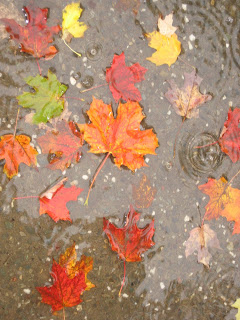
Then, we were in France. The autumn foliage and abundance of water didn’t change, but the stop signs all said ARRET and the shopkeepers “bonjour.” We spent a drizzly day in Quebec, stretching out a three-course lunch of confit du canard and a bottle of Beaujolais to enjoy the mirrored Parisian ambiance of the tony restaurant and avoid going back out into the chill rain. The next day we took the ferry from Levis to the city, sharing the ride with some of the 60,000 Quebecois – couples, kids and dogs – all outfitted in blue “Nordiques” T-shirts off to a Sunday afternoon rally. The hockey-crazed Quebecois lost their team to Colorado in 1995 and think it’s time they had a team of their own again.
We walked the cobbled streets of la Ville Basse, ogled enormous cruise ships in town for fall foliage tours, had lunch in an outdoor café and bought local foie gras, cheese and maple syrup at the public market on the water. And we discovered the guilty Quebec pleasure of poutine: crisp French fries topped with cheese curds and brown gravy, better than it sounds.
We even checked out RVs at a dealership near the campground. “Ah, you speak French,” smiled the salesman, who was also an innkeeper. “Most of the Americans visiting here speak French – or try to. They’re travelers. Not the Canadians from Toronto and Ontario. Not a word, not even ‘bonjour.’”
New Brunswick was all about the Bay of Fundy, whose remarkable tides left fishing boats and beaches high and dry in the afternoon and awash the next morning. We hiked bluffside trails with tumbling streams and frequent waterfalls and walked beaches where the tides had receded 300 feet, exposing rock-anchored strands of kelp six feet long which would be underwater the next day.
Rocky spits reached like bony fingers into inlets strewn with islands, some large enough for a house and dock. The bay was never far from sight, serving as a backdrop to white clapboard houses with mountains of firewood in the front yard and lines of drying laundry in the back. Apple trees heavy with fruit grew along the roads, some planted by wildlife, others by humans. We picked fruit from 150-year-old trees at abandoned homesteads, making cinnamon-scented applesauce for the road. Travel in the north during October is truly an apple fest.
Five time zones and worlds away from California, Nova Scotia evokes the Scotland for which it’s named, all craggy bluffs and weather-worn villages and winds off the sea that knock the feet out from under you. Fishing boats bob at anchor in rocky harbors both picturesque and treacherous.
On a windswept bluff outside Peggy’s Cove, we stopped at the memorial to Swissair flight 111, which plunged into the frigid waters offshore in 1998, killing 229 onboard. The simple granite boulder remembering all those lives lost somewhere out there in that indigo sea was incredibly moving.
The weather grew colder and blustery on Cape Breton island, with moments of bright sunshine punctuating pelting rain to form rainbows that disappeared into deep offshore waters. Here was the full power of the north Atlantic, with biting winds and roiling whitecaps, especially at the end of the dirt road on the northern tip of the island, where chowder houses were already shuttered for the winter and we truly felt at the end of the earth. Thickly wooded inland valleys untouched by humans are home to bears and moose, and we walked a trail in Cape Breton Highlands park through an enchanted forest of towering sugar maples, some of them 350 years old.
The island has a distinctly split personality between Scots and French. Some settlements celebrate their heritage with Celtic song and dance and consonant-heavy names like Whycocomagh, while other French-speaking towns mark the homeland of the Acadians, the French settlers originally deported during British rule in the 1700s. Some of the outcasts made their way back to settle these inhospitable shores and make a living from sea and land, while others left for Louisiana, to become the forebears of today’s Cajuns.
Back at iconic Peggy’s Cove, we talked with Roger, a gentle soul with snow-white hair who’d been born in the tiny village and lived his life among its 50 inhabitants. “I fished for herring and mackerel for 40 years,” he said, “but the catch is down to a fraction of what it used to be.” He glanced out the window of his nautical artifacts shop as a huge tour bus roared by. “I used to go up on that hill as a boy and it was covered in wildflowers. A photographer from New York once took pictures of my sister and I picking wildflowers.” He indicated a granite hill topped with a large inn and parking lot filled with cars and busses, even on a rainy October day. The architecture was tasteful enough, but it had forever changed the view toward the lighthouse.
We talked like three old codgers of a changing world, changing climate and changing populations – down for fish and way up for humans -- while waves lapped against the pilings of the old fishing shack. Finally, we made our way to leave before the next downpour. “Give me a hug,” said Roger. And we did.
. . . . .
For pictures, follow this link:
http://picasaweb.google.com/happytwo.mcwilliams/TripEast6Canada?authkey=Gv1sRgCLH2uqfc5dP9-gE&feat=directlink

1 comment:
Yet another wonderful painterly blog! How I wish I could be a fly on the wall of Happy! Great trip. Love reading these!
Post a Comment